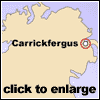
|
The Irish "Killing Time"
By Brian Orr Have a question? Click Here to go to Brian's own Discussion Board! Continued From Page Two
Elsewhere, however, the insurgents ransacked towns and massacred its inhabitants with Protestants of any faith a primary target. This was the "Killing Time" in Ireland. Some of the major towns such as Enniskillen, Londonderry, Coleraine, Carrickfergus, Lisburn and Belfast received timely warning and were able to prepare for and repulse attack . But other small towns and the countryside in general were ravaged. Protestant homes, farms, churches, minister`s houses were torched and the occupants stripped naked and left cowering in the hedgerows in what was one of the severest winters in memory. It was said that the river Blackwater in County Tyrone turned red with the blood of the murdered populace.
At Loughgall some 300 men women and children were stripped of their clothing and locked in the church. They were then selectively assaulted and brutalised, raped, butchered, broiled over hot gridirons and hung drawn and quartered. At Portadown is is reported that 196 persons were hurled into the river and drowned in one day; and that about 1000 in all suffered in this way. Ministers of the Church were dealt with extreme cruelty, hung, dismembered, and one, Thomas Murray of Killyleagh was actually crucified with the bodies of two English gentlemen suspended either side of him in mockery of the Crucifixion.
Into the fray came Major General Munro and 10,000 Scottish troops who arrived in Carrickfergus in February, 1642. Importantly the soldiers were accompanied by their own chaplains who were to play a prominent part in the Presbyterian rebirth in Ireland. These chaplains organised a Session in each regiment and when there were four they created the first regular Presbytery on June 10, 1642. The ministers were Hugh Cunningham who settled at Ray, County Donegal; Thomas Peebles at Dundonald and Holywood; John Baird at Dervock, and; John Aird and John Scott who later returned to Scotland. Support from Scotland soon helped the re-establishment of Presbyterian congregations but more tribulations were to follow.
Munro's excuse was that he did not feel safe in the town without his own troops, and besides there those, meaning Col. Chichester and his regiment, who had declined to accept the Solemn League and Covenant. In the course of this seizure of Belfast a troop of soldiers of Col. Arthur Chichester's regiment had been stood down at Stranmillis, on the outskirts of Belfast. Munro had ordered that they march with drums beating and colours flying to the Market Place and there they were required to ceremonially shred their colours as an indication of obedience to the Scottish army and the Covenant. The duplicity seems to have been unnecessary as the British Colonels placed themselves under his command forthwith but is indicative of the mistrust that existed between the so called allies.
Back to Plantation of Ireland and the Ulster Scots, Main Page
Part One:
The Beginning of the Scotch-Irish
|
Thursday, December 26th, 2019
Attention visitors: Tartans.com is back. Please note that this is a snapshot of the site as it existed nearly 20 years ago and you may encounter broken links; we are still combing through the site and correcting those as we find them. Please also note that some sections are currently not functional, primarily the discussion forums/clan chat boards.
|
** HOME - First Time Visitors - Glossary - - Contact Us ** Awards | Bibliography | Clan Calendar | Clan Chat | Clan Finder | History | Famous Scots | Genealogy | Great Hall of the Clans | Links | News and Features | Scots on the Net | Search | Site Map The Gathering of the Clans
Copyright 1995- Tartans.com - All Rights Reserved. |



